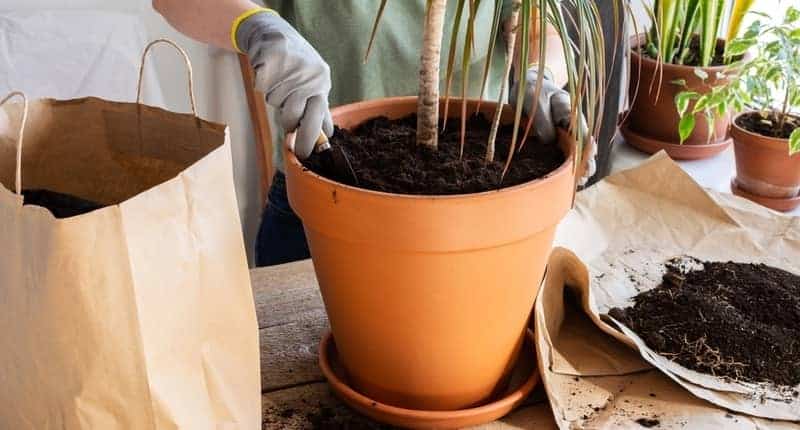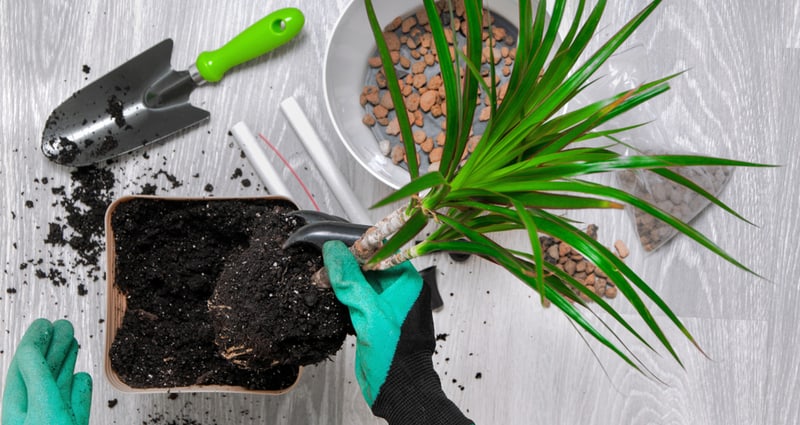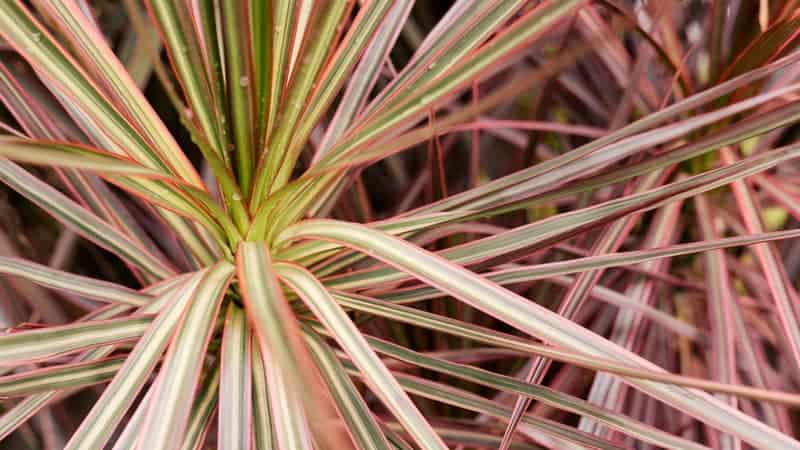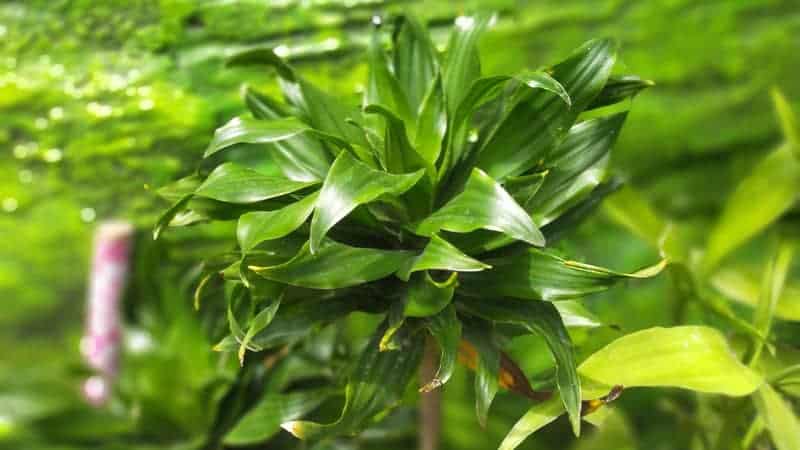If you love indoor plants, chances are you own a Dracaena. It’s a popular houseplant known for its blade-shaped leaves. There are actually several Dracaena species, from the corn plant to the Madagascar dragon tree. And all these Dracaena varieties are excellent additions to your foliage collection.
This indoor plant can tolerate a spectrum of growing conditions. It has flexible lighting requirements, from low light situations to bright indirect light. Try to avoid full sun as this could burn the leaves. Leave the soil to dry between waterings, but don’t let it dry out too much. You can fertilise once or twice a year, but be mindful of build-up and fertiliser burn.
If you’re looking for a beginner-friendly houseplant, look no further than a Dracaena. Here’s your full guide to Dracaena care – and some varieties you might like to grow!
Dracaena Plants 101
Your Dracaena indoor plants are characterised by blade-shaped leaves growing from cane-like main stems. There are several varieties, such as the Song of India and the Lucky Bamboo. They are all broadleaf evergreens, commonly grown as houseplants.
If allowed to mature when planted outdoors, they can reach under 3.0m. But indoors, they more frequently grow to a height of 1.50-1.80m.
Flowers on indoor plants are rare, but possible. Dracaena usually produce yellow or white flowers that bloom periodically.
Dracaena Care
Plant and grow your Dracaena in the spring, although you can pot them indoors year-round. Most of them are slow-growing, and the plants will naturally shed their lower leaves as they mature.
Do not overwater your Dracaena houseplant; this often causes root rot. Yellow leaves are a sure sign that your plant has too-moist soil. Wait for the potting mix to feel dry to touch between waterings – but not completely dry.
(TIP: If you need help caring for a Dracaena – or any other houseplant – an expert gardening service can give you a hand!)
In terms of lighting, these popular houseplants are very flexible. The brighter-coloured ones will thrive best in bright, indirect sunlight – such as from a sunny window – but most will thrive anywhere indoors. Full sun runs the risk of burning the foliage.
When growing potted Dracaena, you should be conscious of repotting every 2–3 years. Replace as much of the old soil as possible, since it will have accumulated fertiliser and minerals from the water you use.
Don’t place your houseplant in an area that’s draughty, such as by an air conditioner or a vent. Cold conditions combined with water can cause rot and collapse.
Planting Dracaena
Fill a pot with well-draining potting mix, ideally with a pH range of 6.0–6.5 (slightly acidic). Make sure you choose a container that is the appropriate size, with drainage holes.
Dig a hole that’s roughly the size of your plant’s root ball – or if your plant came in a small container, a hole that’s about the same depth. This should come out to about 5.0–7.0cm.
Gently place the plant inside the hole and backfill, carefully pressing down the potting mix. Water generously to help the soil settle.
Place the potted plant somewhere with bright but indirect sun. Mist every few days to increase humidity. Then sit back and let your Dracaena grow!
FAQ
You’ve got questions about your Dracaena plant – here are some answers.
Can I overwater a Dracaena?
Yes, you definitely can. You should water thoroughly, but allow the top three-quarters of the soil to dry out before rewatering. Too much moisture will cause root rot, as well as yellowing leaf tips.
What pests affect Dracaena plants?
Keep an eye out for spider mites – they like the hot, dry environment in a house. If you see webbing and stippled foliage, that’s a sure sign that your plant might have spider mites. You can get rid of them by periodically spraying the plant and soil with diluted neem oil.
Are Dracaena toxic?
The leaves are toxic to both pets and humans. Ingestion causes mouth and stomach irritation that can possibly lead to vomiting. Keep out of reach for both pets and small children.
Should I re-pot my Dracaena?
You can re-pot your Dracaena plant when it becomes root bound – usually every two years, or when they’ve exhausted their soil.
How to propagate a Dracaena?
It’s very easy! Simply cut off a section of stem and lay it on its side in warm, moist soil. You can also cut the tip off a stem and dip it in rooting hormone.
Dracaena vs Cordyline
The Cordyline is the Ti plant, and is not the same as a Dracaena. They look similar, but they’re not the same species, although they’re both relatives of the agave. Cordylines have white roots, while Dracaena are yellow to orange.
Dracaena Varieties
You could write a whole essay on Dracaena types alone. Here are some of the most popular varieties and how to care for them.
Dracaena Marginata
This popular Dracaena variety has long, thin leaves edged in red. The Dracaena Marginata plant likes medium, indirect light. If the leaves are bleached, it’s getting too much sun; conversely, pale leaves and slow growth mean not enough light.
The Marginata will reach about 1.80m in height indoors. It’s drought-tolerant and grows slowly. Watch for hardened, compacted soil – that means it needs a soil change.
Dracaena Fragrans
Dracaena Fragrans, the Dracaena Golden Heart or the corn plant, is an evergreen tree with thick stems. Its long, narrow leaves look like stalks of corn. They like bright, indoor locations where they aren’t near direct sunlight or vents. Fragrans thrives best in a high-humidity environment.
Like the Marginata, your Dracaena Fragrans can reach 1.80m in height. Keep soil evenly moist from spring and summer, then reduce watering through winter. Grow them in loose, loamy potting mix.
This plant is also called Dracaena Massangeana.
Dracaena Sanderiana
Also known as “lucky bamboo,” Dracaena Sanderiana isn’t actually a bamboo plant. It does look like one, though, and is frequently grown for its association with “good luck.” It grows well as a hydroponic plant, with its roots kept in water.
Lucky bamboo likes partial shade or indirect sunlight. If the plant begins to stretch, give it more sun. It’s a fast grower, and is sensitive to chlorine, so keep it moist with filtered or distilled water.
Dracaena Tarzan
This is actually a cultivar of the Marginata, with thicker leaves and trunk. Besides that, the leaves are similar – sword-shaped with pink tips. Grow this plant in medium to bright, indirect sunlight and aerate the soil between waterings.
This cultivar is prone to root rot, so avoid overwatering. Let the top 5.0–7.0cm of soil dry out in between watering. You’ll need to water even less if you live somewhere humid, or if you keep your plant near a humidifier.
Dracaena Deremensis
Also called the ‘Compact Janet Craig,’ you can identify a Deremensis by its solid green leaves. These leaves form rosettes along the plant’s stem and reach up to 0.6m long. It prefers medium, indirect light but can tolerate low light.
Deremensis likes comfortable room temperatures – nothing below 13ºC. It needs little plant food, although you can fertilise in spring and summer at half food strength. Keep your plant in a room with average humidity, and give it an occasional misting.
Other dracaena species
There are plenty of other Dracaena, such as the smaller and shrubbier ‘Florida Beauty’ or the ‘Song of India’ with leaves edged in gold. There’s also the ‘Tricolor’ Dracaena that has narrow leaves of red, gold, and green.







